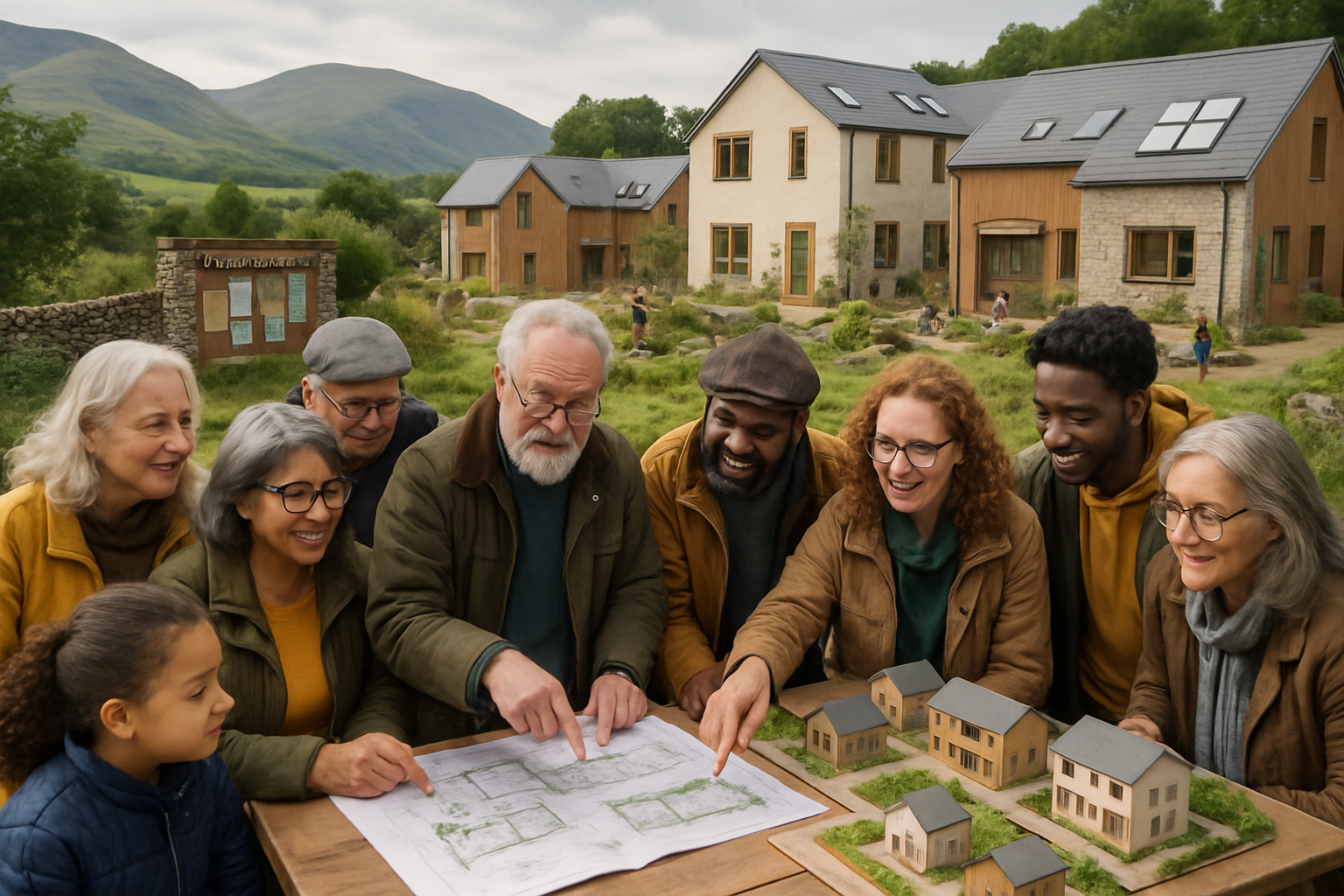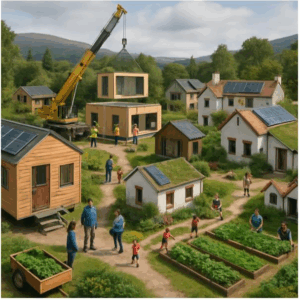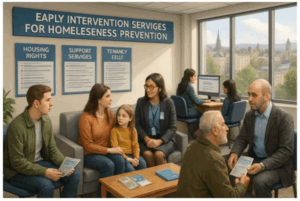Community-led housing represents a transformative approach to addressing Scotland’s housing challenges by placing local communities at the center of housing development decisions. This model empowers residents to identify their housing needs, develop appropriate solutions, and maintain long-term control over their housing assets. With 143 homes already delivered and 504 more in the pipeline as of December 2021, community-led housing is demonstrating its potential to create sustainable, affordable housing while strengthening community bonds and local economies [5].
The concept of community-led housing encompasses various models, from community land trusts and co-housing projects to self-build groups and community-led regeneration initiatives. What unites these approaches is the principle that local communities should have meaningful control over housing development in their areas, ensuring that new housing meets local needs and reflects community values and priorities.
Scotland’s legislative framework provides a strong foundation for community-led housing through the Community Empowerment (Scotland) Act 2015 and the Land Reform (Scotland) Act 2016. These laws establish community rights to buy land, request asset transfers, and participate in local decision-making processes. The Community Right to Buy and the Community Right to Buy Abandoned, Neglected or Detrimental Land provide communities with legal mechanisms to acquire land for housing development, while asset transfer rights enable communities to take control of publicly owned buildings and land.
The success of community-led housing initiatives across Scotland demonstrates the model’s versatility and effectiveness. In the Highlands, the Applecross Community Company has developed affordable housing for local residents, ensuring that young people can remain in their community rather than being forced to move away due to housing costs. The project combines traditional Highland architecture with modern energy efficiency standards, creating homes that are both culturally appropriate and environmentally sustainable.
Urban areas are also seeing innovative community-led housing developments. In Glasgow, the Reidvale Housing Association has worked with local residents to develop community-controlled housing that addresses specific local needs while contributing to neighborhood regeneration. These projects demonstrate that community-led housing is not limited to rural areas but can play important roles in urban housing strategies.
The development process for community-led housing typically begins with community engagement and needs assessment. Local residents identify housing challenges, whether related to affordability, availability, or appropriateness of existing housing stock. This grassroots approach ensures that proposed developments address real community needs rather than external assumptions about what communities require.
Community land trusts represent one of the most established models for community-led housing in Scotland. These organizations acquire land on behalf of the community and develop housing that remains affordable in perpetuity. The Findhorn Foundation’s community land trust in Moray has created a sustainable community with affordable housing, renewable energy systems, and shared facilities that demonstrate the potential for integrated community development.
Co-housing projects offer another model that combines private homes with shared community facilities and decision-making processes. These developments typically feature private apartments or houses alongside shared spaces such as community kitchens, gardens, and meeting rooms. Residents participate in the management and maintenance of their community, creating strong social bonds and mutual support networks.
The financial models for community-led housing require innovation and flexibility to make projects viable while maintaining community control. Many projects combine grant funding from government programs, charitable foundations, and community fundraising with loans from ethical lenders and community investment. The Scottish Government’s Rural Housing Fund and Islands Housing Fund provide important support for community-led projects, while organizations like the Community Housing Trust offer technical assistance and development finance.
Community shares and community bonds offer mechanisms for local residents to invest directly in housing projects, creating both financial returns and community ownership. These approaches can reduce reliance on external funding while ensuring that the benefits of housing development remain within the community. The Fintry Development Trust’s renewable energy and housing projects demonstrate how community investment can support multiple community objectives simultaneously.
The planning system plays a crucial role in enabling or constraining community-led housing development. While Scotland’s planning framework includes provisions for community engagement, the complexity and cost of the planning process can be challenging for community groups with limited resources and expertise. Simplified planning procedures for small-scale community housing projects and enhanced support for community groups navigating the planning system could significantly increase the viability of community-led developments.
Technical expertise and project management capacity represent significant challenges for many community-led housing initiatives. Developing housing requires specialized knowledge of construction, finance, planning, and project management that may not exist within local communities. Organizations like the Community Housing Trust, Development Trusts Association Scotland, and South of Scotland Community Housing provide essential support services, including feasibility studies, project management, and technical assistance.
The role of enabling organizations cannot be overstated in supporting community-led housing development. These intermediary organizations bridge the gap between community aspirations and technical requirements, providing the expertise and resources necessary to transform community ideas into viable housing projects. Their work includes capacity building, training, and ongoing support that enables communities to take on complex development projects.
Community-led housing offers particular advantages in addressing rural housing challenges. Rural communities often face unique housing pressures, including limited housing stock, high property prices driven by second home ownership, and population decline among young people. Community-led approaches can address these challenges by ensuring that new housing serves local needs and remains affordable for local residents.
The integration of community-led housing with broader community development strategies enhances its impact and sustainability. Housing projects that include community facilities, employment opportunities, and environmental improvements create multiple benefits that strengthen the overall community. The Gigha Heritage Trust’s comprehensive community development approach, which includes housing, renewable energy, and economic development, demonstrates the potential for integrated community-led development.
Measuring the success of community-led housing requires consideration of multiple outcomes beyond simple housing numbers. Social cohesion, community capacity, local economic development, and environmental sustainability all represent important measures of success. Research on community-led housing projects consistently shows positive outcomes across these dimensions, with residents reporting higher levels of satisfaction and community engagement compared to conventional housing developments.
The scalability of community-led housing depends on addressing systemic barriers and creating supportive policy environments. While individual projects demonstrate the model’s effectiveness, achieving significant scale requires coordinated support from government, funders, and technical assistance providers. The establishment of regional community housing hubs could provide the coordination and support necessary to increase the number and scale of community-led housing projects.
Policy support for community-led housing needs to address both direct barriers and broader systemic issues. Simplified planning procedures, enhanced funding mechanisms, and technical assistance programs can directly support community-led projects. Broader policies addressing land availability, construction costs, and housing market dynamics also influence the viability of community-led approaches.
The COVID-19 pandemic has highlighted the importance of strong communities and local resilience, factors that community-led housing projects actively promote. Communities with strong social networks and local control over resources have proven more resilient in facing external challenges. This resilience value adds to the case for supporting community-led housing as part of broader community development strategies.
Training and capacity building programs are essential for expanding community-led housing. Communities need access to training in project development, financial management, and construction oversight to successfully deliver housing projects. Educational institutions, professional organizations, and community development agencies all have roles to play in building the capacity necessary for community-led housing development.
The future of community-led housing in Scotland depends on continued policy support, adequate funding, and the development of local capacity and expertise. The model’s proven ability to deliver affordable housing while strengthening communities makes it an important component of Scotland’s housing strategy. By empowering communities to address their own housing needs, community-led housing contributes to both housing supply and community resilience.
Success in scaling community-led housing requires recognition that communities are not just beneficiaries of housing policy but active agents capable of developing and implementing their own solutions. This shift in perspective from top-down delivery to community empowerment represents a fundamental change in how housing policy can be conceived and implemented.
The evidence from existing community-led housing projects demonstrates that communities, when provided with appropriate support and resources, can deliver innovative, sustainable, and affordable housing solutions that meet local needs while contributing to broader policy objectives. The challenge now is to create the conditions for this model to flourish at the scale necessary to make a significant contribution to Scotland’s housing needs.






